To make a tiny room feel bigger and brighter, start by painting everything in light colors—soft whites or pale blues really open up space and reflect natural light. Add oversized mirrors to bounce light and create depth, plus use multi-functional furniture like storage ottomans or wall-mounted desks to save floor space. Don’t forget vertical storage to add height without clutter. Finally, pick one bold focal piece like art or texture to draw the eye. Keep exploring, and you’ll discover even more clever tricks to change your space.
- Key Takeaways
- Use Light Colors to Open Up the Space
- Mirrors: Your Secret Space Expander
- Multi-Functional Furniture That Saves Space
- Vertical Storage Ideas That Add Height
- Floating Furniture for a Clean Look
- Clever Lighting Ideas for Small Rooms
- Minimalist Decor for Maximum Impact
- Use Rugs to Define Separate Zones
- Transform Corners Into Functional Spots
- Add Plants for a Fresh, Airy Feel
- Curtain Tricks to Make Windows Look Larger
- Under-Bed Storage Secrets
- Create a Focal Point with Art or Texture
- Keep It Cohesive with a Simple Color Palette
- DIY Tiny Room Makeover Ideas on a Budget
Key Takeaways
- Use light colors and color drenching on walls, floors, and curtains to reflect light and create an airy, spacious feel.
- Incorporate large and strategically placed mirrors to bounce light and add depth, enhancing the room’s openness.
- Choose multi-functional furniture with built-in storage, such as sofa beds and ottomans, to reduce clutter and save space.
- Utilize vertical storage options like built-in shelves and wall-mounted desks to maximize wall space and maintain floor area.
- Implement layered lighting with recessed lights, wall sconces, and tall lamps to brighten the room without crowding the space.
Use Light Colors to Open Up the Space
When you want to make a tiny room feel bigger, using light colors is one of the smartest tricks you can try. Light color schemes—think soft whites, pale blues, or light grays—use color psychology to open up space by reflecting more light and making walls seem farther away. I love color drenching, where everything—from walls to furniture—is painted the same light shade, creating a smooth, airy vibe. Pairing this with light-colored floors and curtains helps natural light flow freely, making the room feel connected and welcoming. Adding dark accents spices things up without shrinking your space.
Mirrors: Your Secret Space Expander
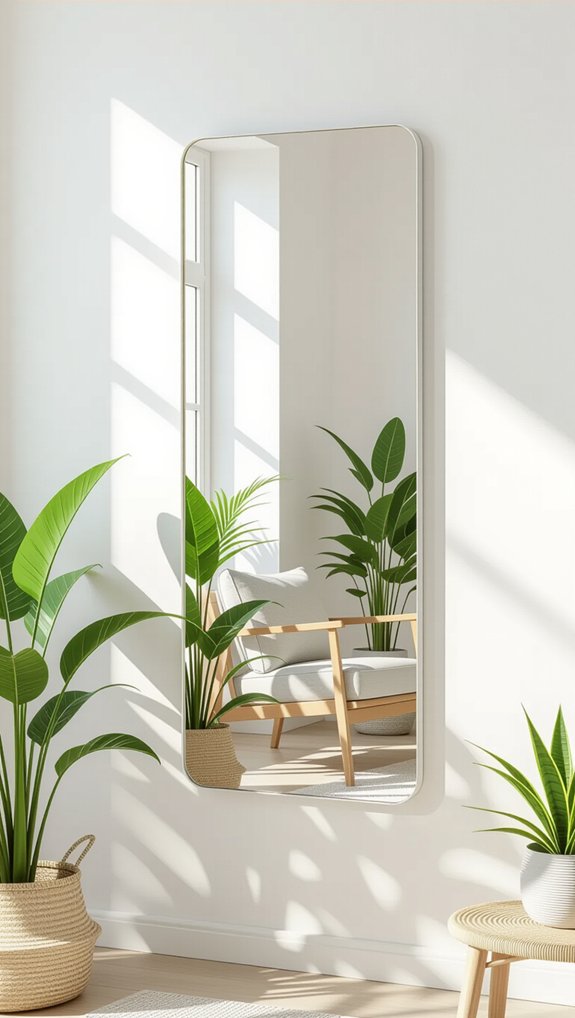
Although tiny rooms can feel cramped, mirrors have a magical way of expanding your space without taking up any extra square footage. I’ve found that smart mirror placement—like above nightstands or over headboards—bounces light around and creates depth, making rooms feel airier. Don’t hesitate to mix mirror styles; oversized mirrors become stunning focal points, while framed mirrors on doors add elegance and practicality. Pairing mirrors with high-contrast artwork really livens the vibe, too. Using different shapes and sizes adds texture and warmth, turning a small space into a cozy, inviting haven that feels much bigger than it is.
Multi-Functional Furniture That Saves Space
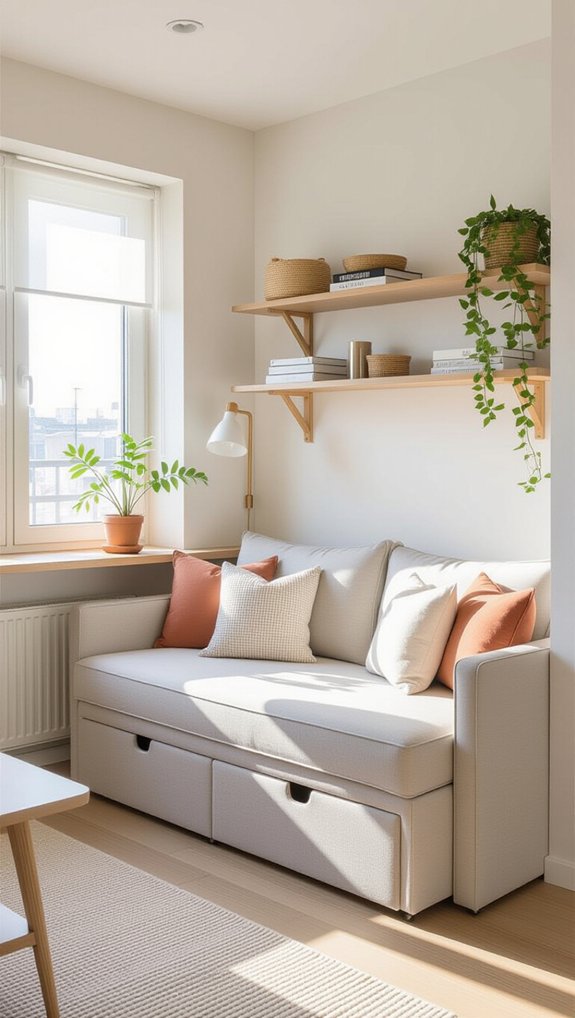
Since every inch counts in a tiny room, I’ve learned that multi-functional furniture is a game-changer for making the most of limited space. Space saving solutions like sofa beds and ottomans with hidden storage help me keep clutter at bay while serving multiple purposes. I also love versatile furnishings such as folding wall-mounted desks and nesting tables—they tuck away neatly, freeing up floor space when I don’t need them. Murphy beds are another favorite, turning a bedroom into a living area effortlessly. Choosing pieces with built-in storage keeps my tiny room organized and bright, making it feel bigger and welcoming.
Vertical Storage Ideas That Add Height
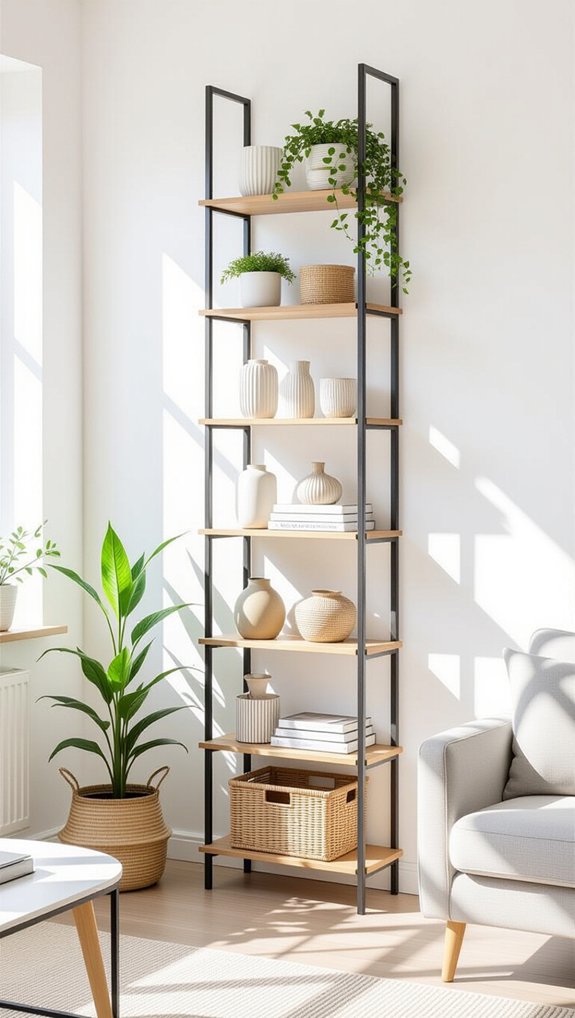
If you want to make a tiny room feel taller and more open, using vertical storage is a smart move that I always recommend. Installing wall mounted shelves draws the eye upward, creating decorative height while freeing up floor space. Tall shelving units or slim bookcases add storage without crowding your room, and hanging plants or decorative items from the ceiling can boost that sense of verticality. I also love using pegboards or wall grids—they’re perfect for organizing stuff and emphasizing height. These simple steps make your small space feel airy and inviting, like it truly belongs to you.
Floating Furniture for a Clean Look

Building on the idea of using vertical space, floating furniture takes that concept a step beyond by lifting your pieces off the floor and giving your tiny room an instant sense of openness. I love using floating shelves and wall mounted tables—they clear the floor and keep things airy. Plus, they’re perfect for keeping clutter at bay while adding style. Here’s what I suggest:
- Install floating shelves for books and decor
- Choose wall mounted tables for work or dining
- Use floating nightstands to save floor space
- Add a floating vanity for a sleek, modern touch
These tricks make cleaning a breeze too!
Clever Lighting Ideas for Small Rooms

When you’re working with a tiny room, clever lighting can completely change the space and make it feel much larger than it really is. I love using recessed lighting paired with dimmer switches to create ambient illumination that’s adjustable and cozy. Flush mount fixtures work great for low ceilings because they don’t crowd the space visually. Tall lamps and wall sconces provide targeted lighting without taking up floor space. Choosing light shades boosts lighting reflection, making the room brighter and airier. Together, these ideas help small rooms feel open, welcoming, and perfectly sized for you.
Minimalist Decor for Maximum Impact
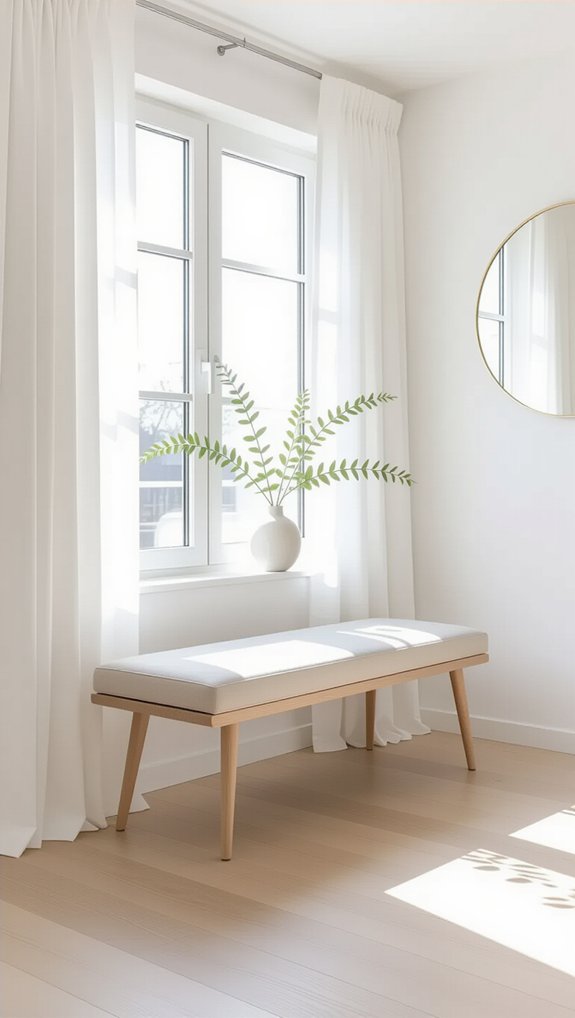
Lighting definitely sets the mood, but what really brings a tiny room together is a thoughtful approach to decor. Embracing minimalist furniture and open shelving creates space without sacrificing style. Here’s how I do it:
- Choose multifunctional pieces like a bed with storage to keep clutter away.
- Use a limited, light color palette to brighten and unify the room.
- Opt for sleek, wall-mounted shelves instead of bulky bookcases to save floor space.
- Pick low-profile furniture that keeps the room airy and open.
These simple steps make any small space feel bigger and more inviting.
Use Rugs to Define Separate Zones
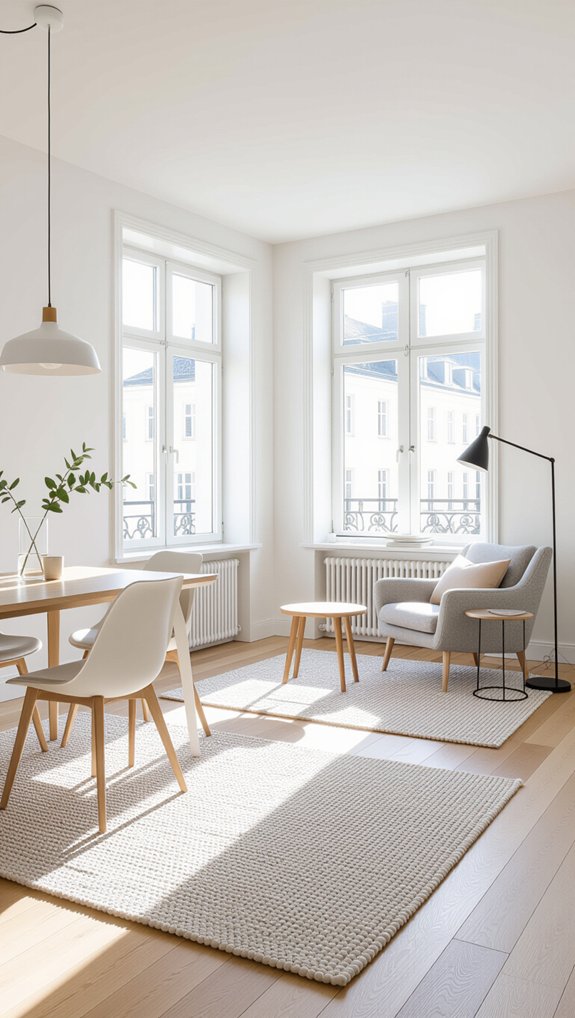
Area rugs are a fantastic way to carve out distinct zones in a tiny room, helping you organize your space without adding walls or bulky dividers. I love using rug placement to anchor furniture—making sure the front legs of chairs or sofas rest on the rug creates a cozy, intentional area. Choosing smaller rugs in light colors keeps the room feeling open while defining separate spots, like a workspace or sitting area. Don’t be afraid to experiment with texture layering by stacking rugs; it adds depth and warmth without cluttering your small space. It’s a simple trick that really makes a difference!
Transform Corners Into Functional Spots
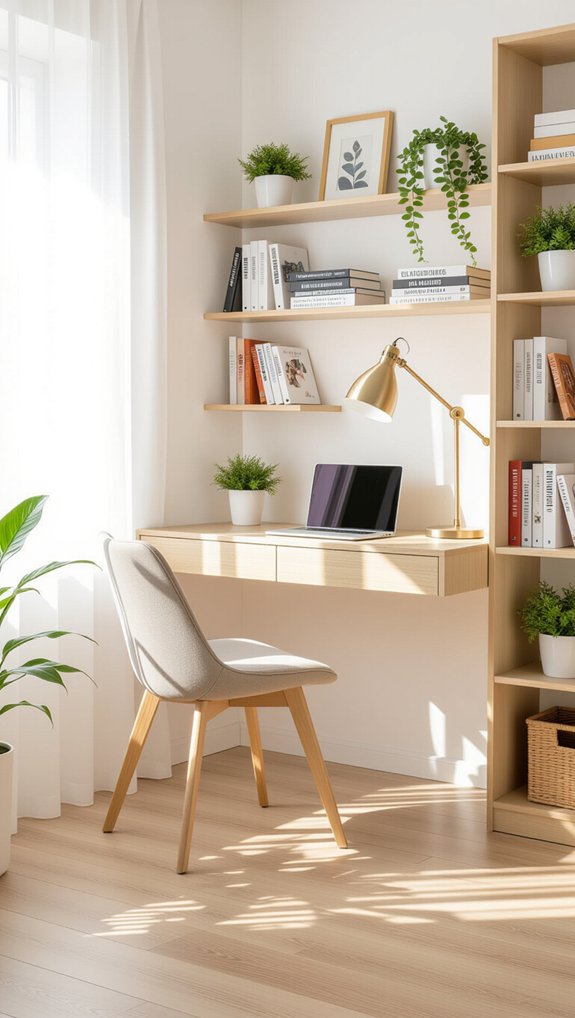
Even though corners often get overlooked, they’re actually goldmines for adding both style and function to a tiny room. By altering these spots, you create cozy, useful areas that make your space feel intentional and welcoming. Try these ideas to enhance corners:
- Install corner shelving to display books or décor without wasting vertical space.
- Add corner seating like a bench with storage underneath for comfort and organization.
- Set up a snug corner desk to carve out a small yet efficient workspace.
- Hang a corner mirror to bounce light around, visually opening up the room.
These simple steps convert forgotten corners into charming, practical places.
Add Plants for a Fresh, Airy Feel
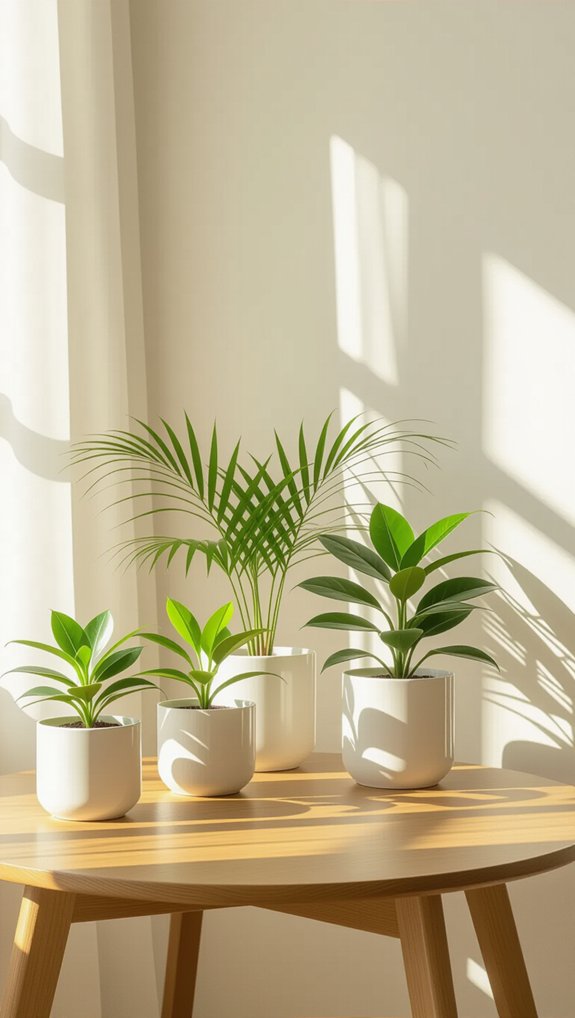
When you bring plants into a tiny room, you’re not just adding decoration—you’re inviting fresh air and life into the space. I love using vertical planters or hanging pots for smart plant placement that saves floor space and draws the eye upward, making the room feel taller. Choosing low-maintenance plants like snake plants or pothos helps me keep things simple while boosting air quality. Placing plants near windows brightens the room naturally and creates a lively focal point. Mixing different heights and textures adds depth, turning small spaces into cozy, fresh spots where you’ll truly belong.
Curtain Tricks to Make Windows Look Larger
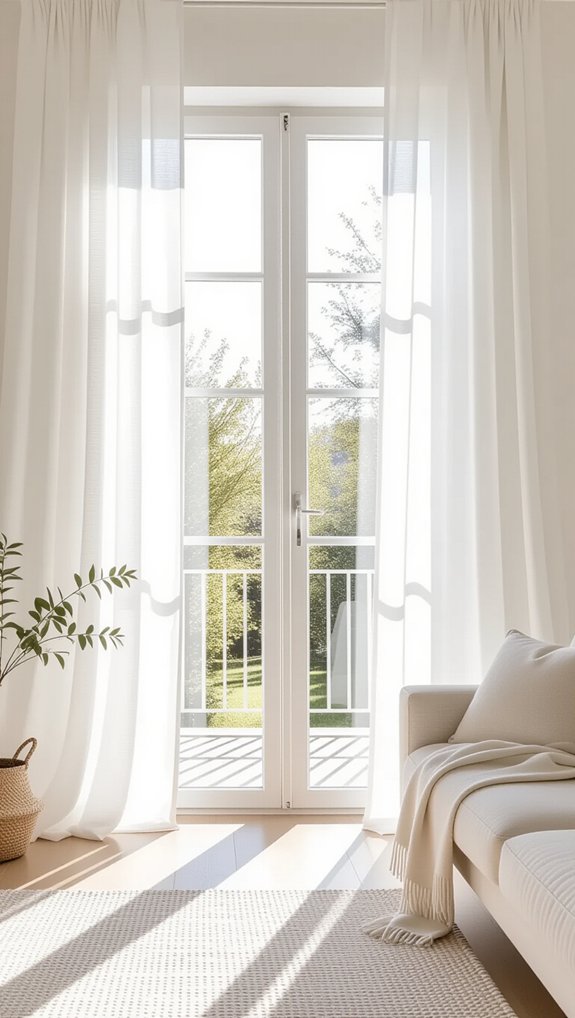
A clever curtain setup can completely change how your windows look and even make your tiny room feel more spacious. I’ve found that paying attention to curtain length and fabric choice makes a big difference. Here’s what works best:
- Hang curtains close to the ceiling to boost window height.
- Pick light fabrics like sheers that let sunlight brighten your room.
- Use rods wider than the window to pull curtains fully aside.
- Choose floor-length curtains with vertical patterns to draw the eye upward.
Try these tricks, and you’ll see your windows—and your cozy space—transform!
Under-Bed Storage Secrets

Since every inch counts in a tiny room, I’ve discovered that under-bed storage is a game changer for keeping things neat and freeing up floor space. By using rolling bins or fabric bags, I optimize storage without cluttering the room. Elevating my bed with risers gave me extra height, perfect for bigger containers. I also label clear bins to stay organized and find what I need quickly—under bed organization made simple! This not only clears the space but makes my room feel cozier and brighter, proving that clever storage can truly reshape a small space.
Create a Focal Point with Art or Texture
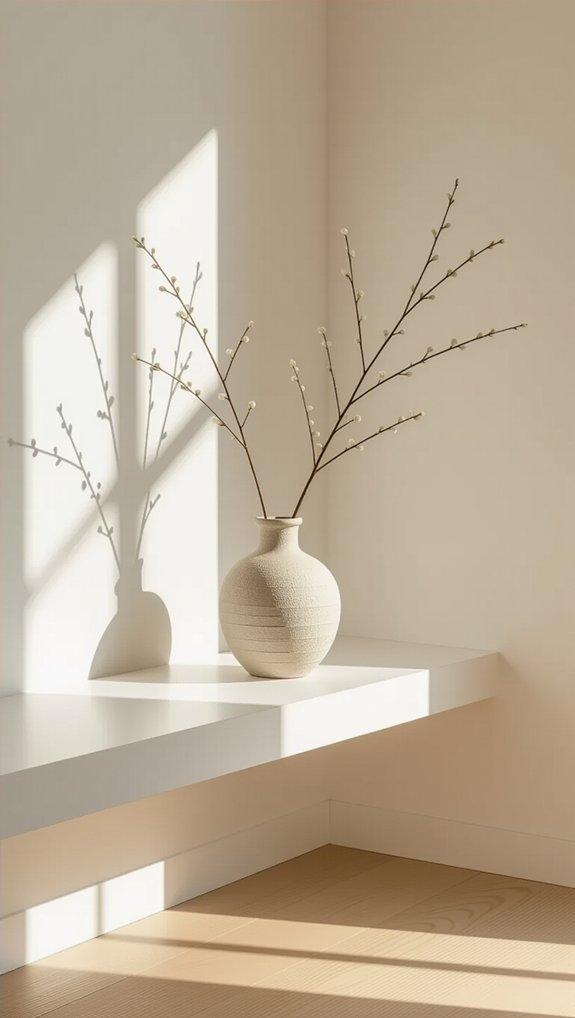
How can you make a tiny room feel bigger and more inviting without adding extra furniture? I love creating a focal point with art or texture—it adds artistic depth and textured contrast that draws the eye and makes the space feel alive. Try these ideas:
- Hang oversized artwork with rich colors against a light wall for visual expansion.
- Use woven wall hangings or 3D pieces to add dimension and cozy warmth.
- Place a mirror near your art to amplify light and create a sense of space.
- Choose one dramatic piece, like a tapestry or sculpture, for a unified, curated look.
It’s all about inviting charm without clutter!
Keep It Cohesive with a Simple Color Palette
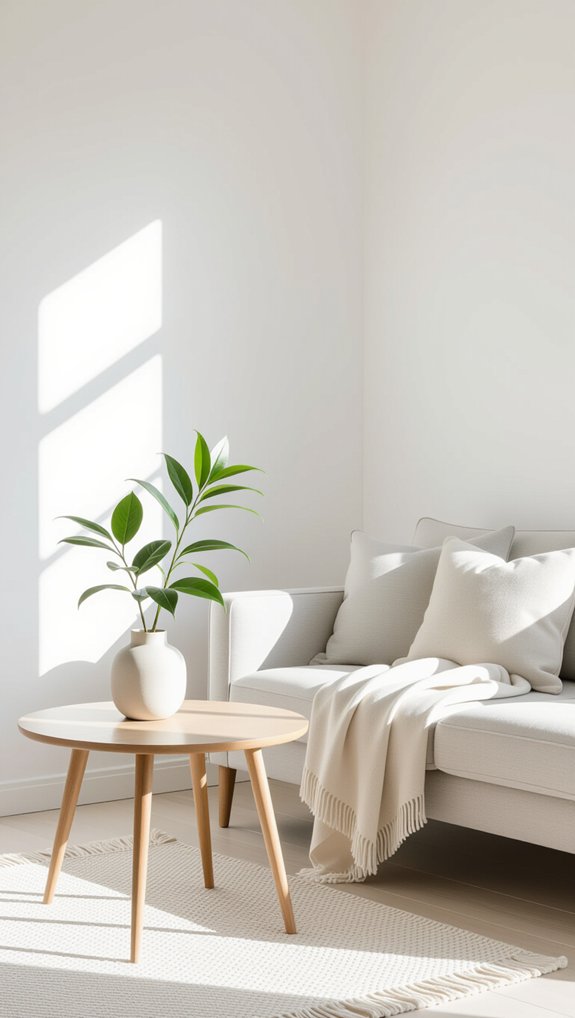
When you stick to a simple color palette, you can actually make a tiny room feel much bigger and more welcoming than you might expect. Color coordination is key to achieving a cohesive design that invites comfort and spaciousness. Using lighter shades and matching curtains, rugs, and furniture creates continuity and reduces visual clutter. Here’s a quick guide:
| Element | Color Idea | Tip |
|---|---|---|
| Walls | Soft pastels | Color drench for continuity |
| Furniture | Neutral shades | Match with walls |
| Accessories | Complementary hues | Add subtle contrast |
| Textiles | Light fabrics | Keep room airy and bright |
Keeping it simple feels like belonging.
DIY Tiny Room Makeover Ideas on a Budget
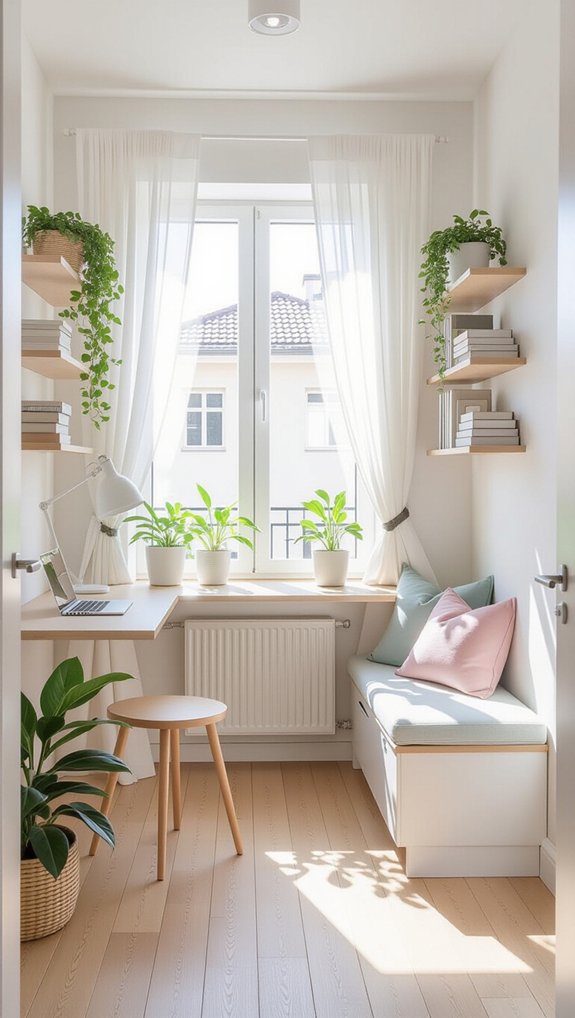
Creating a tiny room that feels open and inviting doesn’t have to break the bank. Using budget friendly paint in a light, uniform shade can visually expand your space by color drenching walls and furniture. Pair this with thrift store finds like mirrors or multifunctional pieces to enhance utility without splurging. Here are some DIY ideas to get you started:
- Paint walls and furnishings the same light color for cohesion.
- Add mirrors above nightstands or on doors to reflect light.
- Use furniture with built-in storage to save space.
- Install wall-mounted shelves or hooks for vertical storage.
These simple tweaks change your tiny room beautifully!




